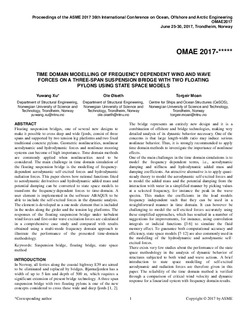Time Domain Modelling of Frequency Dependent Wind and Wave Forces on a Three-Span Suspension Bridge With Two Floating Pylons Using State Space Models
Chapter
Published version
Permanent lenke
http://hdl.handle.net/11250/2479567Utgivelsesdato
2017Metadata
Vis full innførselSamlinger
Originalversjon
10.1115/OMAE2017-62721Sammendrag
Floating suspension bridges, one of several new designs to make it possible to cross deep and wide fjords, consist of three spans and supported by two tension leg platforms and two fixed traditional concrete pylons. Geometric nonlinearities, nonlinear aerodynamic and hydrodynamic forces and nonlinear mooring systems can become of high importance. Time domain methods are commonly applied when nonlinearities need to be considered. The main challenge in time domain simulation of the floating suspension bridge is the modelling of frequency-dependent aerodynamic self-excited forces and hydrodynamic radiation forces. This paper shows how rational functions fitted to aerodynamic derivatives and hydrodynamic added mass and potential damping can be converted to state space models to transform the frequency-dependent forces to time-domain. A user element is implemented in the software ABAQUS to be able to include the self-excited forces in the dynamic analysis. The element is developed as a one node element that is included in the nodes along the girder and the tension leg platforms. The responses of the floating suspension bridge under turbulent wind forces and first-order wave excitation forces are calculated in a comprehensive case study and compared with results obtained using a multi-mode frequency domain approach to illustrate the performance of the presented time-domain methodology.
